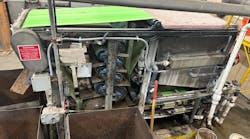Costly, time-consuming and persistent maintenance problems, coupled with unacceptable odor levels, prompted a major southwest wastewater treatment plant to scrap its sludge handling system.
The facility had been using a conveyor to move the sludge cake from belt filter presses to holding hoppers. Continual spillage of sludge cake off the conveyor proved an insurmountable problem, especially as the plant expanded.
With a rated capacity of 17.5 mgd, the Northwest Wastewater Treatment Plant (NWTP), owned and operated by El Paso Water Utilities Public Service Board, El Paso, Texas, currently processes about 9 mgd, serving primarily a residential user base.
NWTP has invested heavily to ensure that odorous treatment units are fully enclosed and exhaust air is scrubbed before being discharged into the atmosphere. The plant's effluent is filtered to reduce turbidity and is disinfected before discharge into the Rio Grande River, with a portion being used as reclaimed water in industrial and irrigation applications.
The original 5 mgd NWTP, built in 1986, operated with two belt filter presses and two short conveyors used to transport the final 18% to 22% biosolids to waiting semi-trailers.
When the NWTP tripled its capacity in 1995, a third filter press was added, with the existing 20-in. wide conveyor belt extended several yards to accommodate the additional sludge output.
During the pre-expansion operation, the 15-fpm chain and sprocket conveyor system, with rectangular scoop-type collecting pans, moved sludge cake directly to trucks for disposal. When the plant expanded, two 20 cu ft capacity holding hoppers were added. The extended conveyor then collected dewatered sludge from all three presses and carried it at a 45° incline to a central trough, where two new screw conveyors would split flow into the holding hoppers. The three presses are located 60 ft, 40 ft and 20 ft from the trough.
When the plant operated all three presses, the finished sludge from each would be deposited onto the main conveyor. But pans became overloaded, sludge spilling off the conveyor and onto the floor.
This sludge overflow prevented the required amount of sludge from reaching the holding hoppers. Additionally, noxious odors rose from the spillage, which often was not cleaned up for eight to ten hours. This could be a serious problem since the plant is located in a highly odor-sensitive part of the city, six miles west of downtown El Paso.
Maintaining the conveyor system with its chain-belt mounted rubber pans proved expensive and labor-intensive. When the conveyor reached the end of the line, ripped pans would stretch open and allow sludge to fall through. Operators, washing down the conveyor at day's end, would have to change ripped pans, a time-consuming task as each pan was attached with eight nuts and bolts.
The conveyor was literally ripping itself apart and occasionally jumped the track, because of excess accumulation of spilled sludge in the sprockets. Operators could take two to three days to repair the conveyor.
Looking for a permanent solution, NWTP turned to TP Pump & Pipe Company in Albuquerque, N.M., a regional fluids handling firm. They supplied three type BTE 17-12 PC pumps manufactured by seepex Inc. in Enon, Ohio. The 25-gpm capacity sludge pumps have gray cast iron housings, NBR stators, and Duktil-coated hardened tool steel rotors.
The BTE design can pump up to 35% solids sludge, has an enlarged rectangular feed hopper with removable compression zone, and a high volume ribbon-screw auger with enlarged diameter and pitch. The hopper length was matched to the discharge of the dewatering device.
During operation, the positive displacement pump's single external helix rotor turns within a double internal helix stator to form progressively moving cavities, creating the pumping action. The pump's output is directly proportional to its speed, and its customized stator ensures an identical compression ratio along the entire length of the rotor/stator interface.
A seepex pump was installed at the discharge of each filter press. A specially designed tapered stainless steel chute was fabricated to allow dewatered sludge to gravity feed into each BTE unit's open hopper, with a 20-in. clearance to minimize odor. The three pumps transfer the sludge via a 6-in. pipeline to the central trough feeding the two screw augers.
The pumps were installed one at a time, the farthest (60 ft) first, to assure each unit's performance.
After the units had been in operation for several months, the farthest pump began to show signs of wear. To correct this, the plant installed a 2-in. chemical injection ring to meter polymer into the annulus of the sludge pipe, using a separate seepex PC metering pump. While the polymer injection system lowered the system pressure, the wear problem on the most distant pump persisted.
NWTP resolved this pump abrasion issue in August 2000, by upsizing the capacity of the farthest two pumps by 25%—a simple matter of switching out the pumps' rotors, stators, and some fittings. The original PVC 6-in. pipeline was replaced with stainless steel, and the new dewatered sludge transfer system has operated smoothly and efficiently ever since.
As a result of installing the new seepex PC pumps, the NWTP has significantly reduced maintenance costs and improved operator morale:
* The pumps rarely require repair; when they do, two operators can change a unit's rotor and stator in just two hours, and
* The new pumps have eliminated the unpleasant, odorous task of spillage cleanup, very important since El Paso heat can make odors unbearable.

